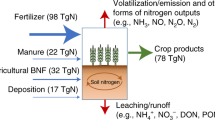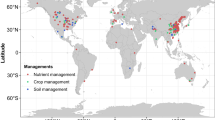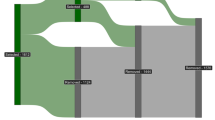Abstract
Nitrogen use efficiency (NUE) is a key indicator with which to study nitrogen cycles and inform nitrogen management. However, different quantification approaches may result in substantially divergent NUE values even for the same production system or for the same experimental plot. Based on our investigation of the differences between and connections among the three principal approaches for NUE quantification, we offer recommendations for choosing the appropriate approach and call for long-term observations to assess the impacts of management practices.
This is a preview of subscription content, access via your institution
Access options
Access Nature and 54 other Nature Portfolio journals
Get Nature+, our best-value online-access subscription
$29.99 / 30 days
cancel any time
Subscribe to this journal
Receive 12 digital issues and online access to articles
$119.00 per year
only $9.92 per issue
Buy this article
- Purchase on Springer Link
- Instant access to full article PDF
Prices may be subject to local taxes which are calculated during checkout


Similar content being viewed by others
Data availability
This work used data collected from a variety of publicly available sources. See the references in the main text and Supplementary Information for data specification.
Code availability
The code used for this analysis is available from the corresponding author on request.
References
Zhang, X. et al. Managing nitrogen for sustainable development. Nature 528, 51–59 (2015).
Erisman, J. W. et al. Nitrogen: Too Much of a Vital Resource. WWF Science Brief (WWF Netherlands, 2015); http://www.louisbolk.org/downloads/3005.pdf
European Union Nitrogen Expert Panel. Nitrogen Use Efficiency (NUE)—An Indicator for the Utilization of Nitrogen in Agriculture and Food Systems (Wageningen University, 2015); http://wedocs.unep.org/handle/20.500.11822/12087
Cassman, K. G., Dobermann, A. & Walters, D. T. Agroecosystems, nitrogen-use efficiency, and nitrogen management. Ambio 31, 132–140 (2002).
Harmsen, K. A comparison of the isotope-dilution and the difference method for estimating fertilizer nitrogen recovery fractions in crops. I. Plant uptake and loss of nitrogen. NJAS: Wageningen J. Life Sci. 50, 321–347 (2003).
Krupnik, T. J., Six, J., Ladha, J. K., Paine, M. J. & van Kessel, C. An Assessment of Fertilizer Nitrogen Recovery Efficiency by Grain Crops (Island Press, 2004).
Jin, J. Changes in the efficiency of fertiliser use in China. J. Sci. Food Agric. 92, 1006–1009 (2012).
Zhang, F. et al. Nutrient use efficiencies of major cereal crops in china and measures for improvement. Acta Pedol. Sin. 45, 915–924 (2008) (in Chinese with English abstract).
Yu, F. & Shi, W. Nitrogen use efficiencies of major grain crops in China in recent 10 years. Acta Pedol. Sin. 52, 1311–1324 (2015) (in Chinese with English abstract).
Ju, X. & Christie, P. Calculation of theoretical nitrogen rate for simple nitrogen recommendations in intensive cropping systems: a case study on the North China Plain. Field Crops Res. 124, 450–458 (2011).
Zhang, C., Ju, X., Powlson, D., Oenema, O. & Smith, P. Nitrogen surplus benchmarks for controlling N pollution in the main cropping systems of China. Environ. Sci. Technol. 53, 6678–6687 (2019).
Powlson, D. S. et al. Comments on ‘Synthetic nitrogen fertilizers deplete soil nitrogen: a global dilemma for sustainable cereal production,’ by R.L. Mulvaney, S.A. Khan, and T.R. Ellsworth in the Journal of Environmental Quality, 2009 38: 2295–2314. J. Environ. Qual. 39, 749–752 (2010).
Yan, X. et al. Fertilizer nitrogen recovery efficiencies in crop production systems of China with and without consideration of the residual effect of nitrogen. Environ. Res. Lett. 9, 095002 (2014).
Smith, C. J. & Chalk, P. M. The residual value of fertiliser N in crop sequences: an appraisal of 60 years of research using 15N tracer. Field Crops Res. 217, 66–74 (2018).
Ju, X. et al. Reducing environmental risk by improving N management in intensive Chinese agricultural systems. Proc. Natl Acad. Sci. USA 106, 3041–3046 (2009).
Wang, L. et al. Plastic mulching reduces nitrogen footprint of food crops in China: a meta-analysis. Sci. Total Environ. 748, 141479 (2020).
Storkey, J. et al. Grassland biodiversity bounces back from long-term nitrogen addition. Nature 528, 401–404 (2015).
Sebilo, M., Mayer, B., Nicolardot, B., Pinay, G. & Mariotti, A. Long-term fate of nitrate fertilizer in agricultural soils. Proc. Natl Acad. Sci. USA 110, 18185–18189 (2013).
Raun, W. R. & Johnson, G. V. Improving nitrogen use efficiency for cereal production. Agron. J. 91, 357–363 (1999).
Yan, M., Pan, G., Lavallee, J. M. & Conant, R. T. Rethinking sources of nitrogen to cereal crops. Glob. Change Biol. 26, 191–199 (2020).
Acknowledgements
We thank M. Glendining from Rothamsted Research for providing us with the data to indicate the changes of NUE in the long-term Broadbalk Wheat Experiment. Z.Q. is supported by the National Key Research and Development Program of the Ministry of Science and Technology of China (2018YFC0213305), the National Natural Science Foundation of China (41701309) and the Open Research Project of Shouguang Facilities Agriculture Center in the Institute of Applied Ecology (2018SG-B-03). X.Z. is supported by the National Science Foundation (CNS-1739823, CBET-2047165, and CBET-2025826). Y.F. is supported by the National Key Research and Development Program of the Ministry of Science and Technology of China (2016YFA0600802). We also acknowledge support from the Youth Innovation Promotion Association CAS (Z.Q.) and the K.C. Wong Education Foundation (Y.F.).
Author information
Authors and Affiliations
Contributions
Z.Q., X.Z. and Y.F. designed the study. Z.Q. and X.Z. collected data and conducted calculations. Z.Q., X.Z. and Y.F. led the analysis. All authors contributed to writing and revisions.
Corresponding authors
Ethics declarations
Competing interests
The authors declare no competing interests.
Additional information
Peer review information Nature Food thanks Tai Maaz and the other, anonymous, reviewer(s) for their contribution to the peer review of this work.
Publisher’s note Springer Nature remains neutral with regard to jurisdictional claims in published maps and institutional affiliations.
Extended data
Extended Data Fig. 1 The average NUE values estimated by NUEdiff, NUE15N, and NUEbala approaches in the Chinese wheat, rice, and maize cropping system.
Equations in Table 1 (NUEdiff = (HNT - HNC) / FN; NUE15N = (HNT × %Ndff) / FN; NUEbala = HNT / (FN + NFN)) were used to estimate the average NUEdiff, NUE15N, and NUEbala for the three major cereal crops within China’s cereal cropping system. Data sources: the average %Ndff was from Supplementary Table 2; HNC was calculated as the product of HNT and the ratio of HNC to HNT which was estimated based on the observed yield response to fertilizer nitrogen input in Supplementary Fig. 4 and the observed nitrogen concentration response to fertilizer nitrogen input in Supplementary Table 5; the average HNT and FN were from Supplementary Table 3; the average NFN was from Supplementary Table 4 (asymbiotic N fixations were estimated as 30 kg N ha−1 for rice, and 10 kg N ha−1 for wheat or maize). See Fig. 1 caption for definitions of abbreviations.
Extended Data Fig. 2 The potential impact of non-fertilizer nitrogen bioavailability on the NUE for FN use based on the N balance approach (NUEbala_F).
See the legend of Fig. 1 for definitions of abbreviations. According to Fig. 2a, NUEdiff, NUE15N, and NUEbala correspond to the slope of line BD, CD, and OD respectively. Numbers in brackets are from an example developed for the Chinese cereal cropping system. Point A was derived as the cross-point of line OD and the vertical line BC. Strictly speaking, NUEbala measures the efficiency of total N inputs instead of fertilizer inputs only, because the denominator for NUEbala is FN + NFN instead of FN. To derive the NUE for fertilizer based on NUEbala (NUEbala_F, the slope of pD, where p represents a point on the line MN and is not noted in the figure), the non-fertilizer nitrogen input (NFN) and its bioavailability (BANF, or the slope of Op) need to be quantified. When BANF is the same as NUEbala, point p overlaps with point A, and the NUEbala_F is the same as NUEbala (0.52, the red dotted line). If all NFN is harvested as crop products (BANF=1; the maximum value of BANF), then point p moves to point M, and NUEbala_F is the slope of line MD (NUEbala_F=0.38). In contrast, if no NFN is harvested as crop products (BANF=0; the minimum value of BANF), then point p moves to point N, and NUEbala_F is the slope of line ND (NUEbala_F=0.66). Therefore, based on NUEbala for the Chinese cereal cropping system example, the lowest possible value for NUEbala_F is 0.38, and it is still higher than NUE15N (0.30) and NUEdiff (0.32), indicating other important drivers for the differences between NUEbala and the other two approaches.
Extended Data Fig. 3 The yield response curves from short-term and long-term observations, and the relationship between observed NUEdiff and NUEbala.
A typical yield response curve based on field trials shows a “diminishing return” to N inputs. For experimental sites that have been under fertilizer N treatment over a period of time, the yield observed at the control plot tends to decrease over time (the red point on the vertical dashed line of NFN moves downward), mainly due to the gradually reducing legacy effect of N input before the setting of the control plot. See the legend of Fig. 1 for definitions of abbreviations. The slopes of red lines are NUEdiff and NUEbala.
Supplementary information
Supplementary Information
Supplementary notes 1 and 2, discussions 1 and 2, Tables 1–6 and Figs. 1–3.
Rights and permissions
About this article
Cite this article
Quan, Z., Zhang, X., Fang, Y. et al. Different quantification approaches for nitrogen use efficiency lead to divergent estimates with varying advantages. Nat Food 2, 241–245 (2021). https://doi.org/10.1038/s43016-021-00263-3
Received:
Accepted:
Published:
Issue Date:
DOI: https://doi.org/10.1038/s43016-021-00263-3
This article is cited by
-
Agricultural management practices in China enhance nitrogen sustainability and benefit human health
Nature Food (2024)
-
High level of copper affects both nitrogen transport in rice plant and nitrogen transformation in rhizosphere soil
Plant and Soil (2024)
-
Residue recycling options and their implications for sustainable nitrogen management in rice–wheat agroecosystems
Ecological Processes (2023)
-
Spatially differentiated nitrogen supply is key in a global food–fertilizer price crisis
Nature Sustainability (2023)
-
Global mean nitrogen recovery efficiency in croplands can be enhanced by optimal nutrient, crop and soil management practices
Nature Communications (2023)



